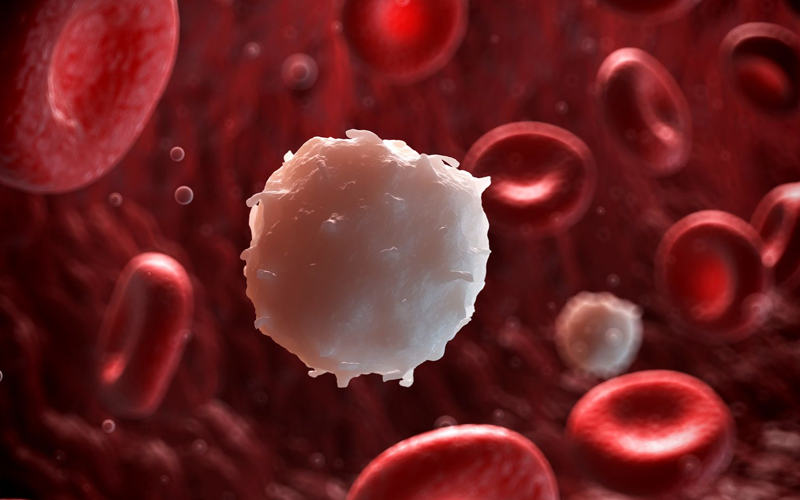White Blood Cell Disorders
Blood is made up of three different types of blood cells, all of which are produced by the bone marrow:
- red blood cells, which carry oxygen
- platelets, which seal wounds and stop bleeding
- white blood cells, also called “leukocytes,” which help fight infections
There are several different types of white blood cells, each of which has a specific role in protecting the body from infection:
- neutrophils, which fight bacteria and fungal infections
- lymphocytes, which fight viruses, produce antibodies, and regulate the immune system
- monocytes/macrophages, which are “professional” germ-eating cells
- eosinophils and basophils, both of which help fight parasites and are related to allergic responses
Many disorders can cause the bone marrow to produce too many or too few white blood cells, or to produce white blood cells that do not function as they should.

White Blood Cell Disorders Treatment
Patients with white blood cell disorders are treated through the Blood Disorders Center. Continue reading about white blood cell disorders or visit the Blood Disorders Center to learn more about treatment options and our pediatric hematologists.
What are the types of white blood cell disorders?
White blood cell disorders occur when the white blood cell count is too low or too high, or when the white blood cells are not functioning properly.
White blood cell disorders of neutrophils and lymphocytes are the most common. Disorders that involve monocytes and eosinophils are less common; basophil disorders are rare. Lymphocyte disorders are treated jointly between the Blood Disorders Center at Dana-Farber/Boston Children’s and the Immunology Program at Boston Children’s Hospital.
Examples of disorders that occur when the white blood cell count is low:
- Neutropenia is the general term for low numbers of neutrophils in the blood. Neutropenia can be congenital (due to genetic causes) or acquired (caused by medications/drugs, toxins, viruses or attacks from the child’s own immune system).
- Shwachman-Diamond syndrome is a rare inherited disease marked by pancreas dysfunction and congenital neutropenia—low numbers of neutrophils due to insufficient production.
- Kostmann syndrome is a severe form of congenital neutropenia. In this inherited disorder, the blood virtually lacks neutrophils because they do not mature properly. Patients present with infections and mouth sores early in life.
Examples of disorders that occur when the white blood cell count is high:
- Eosinophilia is a rare increase in the number of eosinophils in the blood, usually as a result of signals produced by other cells calling for more eosinophil production.
- Neutrophilia is an increase in the number of neutrophils in the blood. Most commonly, neutrophilia is acquired and occurs in response to infections or drugs. Other rare causes exist.
Examples of disorders that occur when white blood cells malfunction:
- Chronic granulomatous disease is an inherited disorder in which neutrophils, monocytes and macrophages (which together are called phagocytes for their ability to eat or “phagocytose” pathogens) are unable to efficiently fight bacteria and fungal infections.
- Leukocyte adhesion deficiency is a rare inherited group of diseases in which the white blood cells are unable to produce the proteins they need in order to travel to the site of an infection.
- Myeloperoxidase deficiency is a disorder in which the enzymes that help neutrophils fight bacteria are lacking.
- Chediak Higashi syndrome is a very rare inherited disorder in which cells of the immune system can’t properly store and release important enzymes.
What are the symptoms of white blood cell disorders in children?
Symptoms depend on the type of white blood cell disorder a child has. Common symptoms when white blood cells are too few or don’t function properly include:
- frequent infections, most often in the lungs, ears or sinuses
- skin abscesses
- mouth sores
- invasive fungal infections
- severe tooth and gum (periodontal) disease
Certain conditions can have unique symptoms, such as:
- delayed wound healing in leukocyte adhesion deficiency
- chronic, sometimes greasy diarrhea in Shwachman-Diamond syndrome
How are white blood cell disorders in children diagnosed?
Depending on the type of white blood cell disorder a child has, the doctor may order:
- blood work to evaluate white blood cells’ number and morphology (appearance)
- bone marrow testing
Doctors may order additional specific tests to confirm or rule out certain disorders, such as:
- specific tests for leukocyte function
- stool sample for Schwachman-Diamond syndrome
After all tests are completed, hematologists will be able to outline the best treatment options.
How are childhood white blood cell disorders treated?
Treatment depends on the underlying problem (e.g., acquired, congenital) and severity and may include:
- Treatment of symptoms, e.g., oral or intravenous antibiotics to fight infection
- Colony-stimulating factor to stimulate the bone marrow to produce more white blood cells
Stem cell (bone marrow) transplant may be an option for severe congenital diseases. Bone marrow transplant involves the replacement of diseased bone marrow with another person’s healthy bone marrow. Unfortunately, it may not be an option for everyone. The success of a transplant depends on many factors, such as how close the match is between child and donor (matched siblings are best; if your child has a sibling, there is a 1 in 4 chance they will be a match) and the patient’s age. The decision to proceed with bone marrow transplant should be discussed with your child’s hematologist and a stem cell transplant team.
What is the latest research on childhood white blood cell disorders?
Thanks to ongoing research, treatment for patients with low white blood cell counts has improved significantly over the past 20 years. Genetic testing, which is now available for many congenital white blood cell disorders, including congenital neutropenias, has allowed better estimation of a patient’s prognosis. Improved treatment and supportive care is helping patients with even the most severe of the neutrophil disorders to live longer.
White Blood Cell Disorders Frequently Asked Questions
If you Have Any Queries, Call Us On
+91-8193809030
